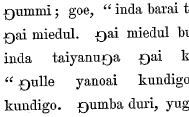Eng (letter)

Eng or engma (capital: Ŋ, lowercase: ŋ) is a letter of the Latin alphabet, used to represent a velar nasal (as in English singing) in the written form of some languages and in the International Phonetic Alphabet.
History
The First grammatical treatise, a 12th-century work on the phonology of the Old Icelandic language, uses a single grapheme for the eng sound, shaped like a g with a stroke ⟨g⟩.
Alexander Gill the Elder uses an uppercase G with a hooked tail and a lowercase n with the hooked tail of a script g ⟨ŋ⟩ for the same sound in Logonomia Anglica in 1619.[1]
William Holder uses the letter in Elements of speech: An essay of inquiry into the natural production of letters published in 1669, however it was not printed as intended, he indicates in his errata that “there was intented a character for Ng, viz., n with a tail like that of g, which must be understood where the Printer has imitated it by n or y”.[2]
It was later used in Benjamin Franklin phonetic alphabet, with its current phonetic value.
Appearance
Lowercase eng is derived from n with the addition of a hook to the right leg, somewhat like that of j. The uppercase has two variants: it can be based on the usual uppercase N, with a hook added (or "N-form"); or it can be an enlarged version of the lowercase (or "n-form"). The former is preferred in Sami languages that use it, the latter in African languages[citation needed].

Early printers, lacking a specific glyph for eng, sometimes approximated it by rotating a capital G, or by substituting a Greek eta (η) for it (encoded in Unicode as the Latin letter n with long leg: Ƞ ƞ).
-
.svg.png)
Italic ŋ based on double storey g as used in Horatio Hale (1846) Ethnography and Philology.
Usage
Technical transcription
- Americanist phonetic notation (where it may also represent a uvular nasal)
- Sometimes for the transcription of Australian Aboriginal languages
- International Phonetic Alphabet
- Uralic Phonetic Alphabet
- Rheinische Dokumenta, a phonetic alphabet for many West Central German, the Low Rhenish, and few related languages
Vernacular orthographies
 |
 |
| Janalif variant of Eng is represented as N with descender. An equivalent version is used in the Cyrillic alphabet. | |
Languages marked † no longer use eng, but formerly did.
- African languages
- American languages
- Australian Aboriginal languages
- Bandjalang
- Yolngu
- Languages of China
- Zhuang† (replaced by the digraph ng in 1986)
- Sami languages
- Inari Sami
- Lule Sami
- Northern Sami
- Skolt Sami
- Turkic languages during Latinisation (USSR) used Ꞑ ꞑ, sometimes considered a variant of Eng.
Computer encoding
Eng is encoded in Unicode as U+014A LATIN CAPITAL LETTER ENG and U+014B LATIN SMALL LETTER ENG, part of the Latin Extended-A range. In ISO 8859-4 (Latin-4) it's located at BD (uppercase) and BF (lowercase).
In African languages such as Bemba, ng' (with an apostrophe) is widely used as a substitute in media where eng is hard to reproduce.
See also
- Ng (digraph)
- Nh (digraph)
Similar Latin letters:
Similar Cyrillic letters:
- Ӈ ӈ
- Ң ң
- Ҥ ҥ
| Aa | Bb | Cc | Dd | Ee | Ff | Gg | Hh | Ii | Jj | Kk | Ll | Mm | Nn | Oo | Pp | Rr | Ss | Tt | Uu | Vv | Ww | Xx | Yy | Zz | ||
| Letter N with diacritics | ||||||||||||||||||||||||||
| Ńń | Ǹǹ | Ňň | Ññ | Ṅṅ | Ņņ | Ṇṇ | Ṋṋ | Ṉṉ | N̈n̈ | Ɲɲ | Ƞƞ | Ŋŋ | Ꞑꞑ | ᵰ | ᶇ | ɳ | ȵ | |||||||||
| Related | ||||||||||||||||||||||||||
References
- ↑ David Crystal (2003). The Cambridge Encyclopedia of the English Language
- ↑ Robert W. Albright (1958). The International Phonetic Alphabet: Its Backgrounds and Development, Indiana University. p. 11
External links
- Practical Orthography of African Languages
- FileFormat.info – Fonts that support LATIN CAPITAL LETTER ENG (U+014A) and LATIN SMALL LETTER ENG (U+014B)